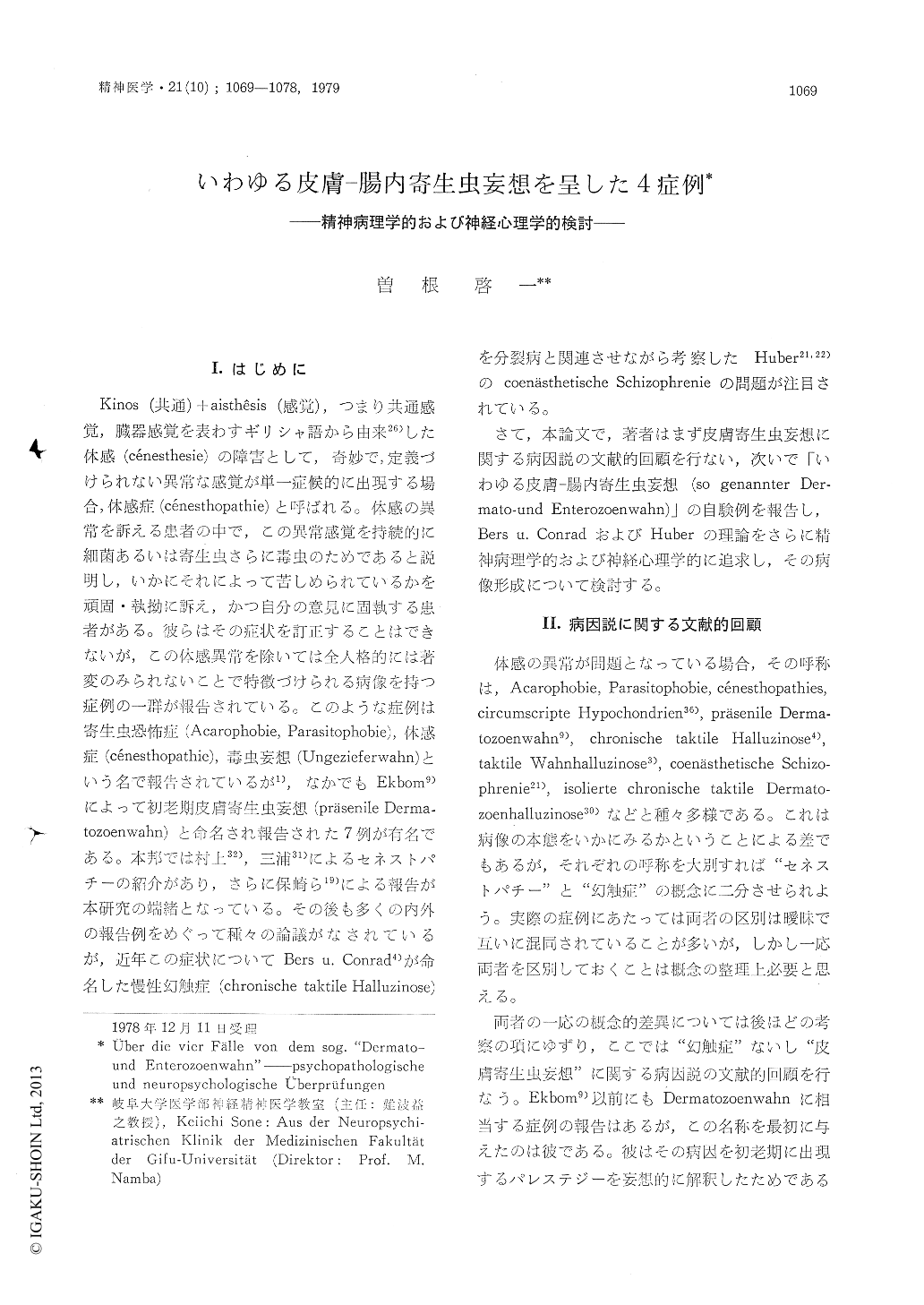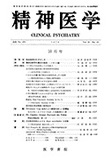Japanese
English
- 有料閲覧
- Abstract 文献概要
- 1ページ目 Look Inside
「いわゆる皮膚—腸内寄生虫妄想」の4例を報告した。
本症の成立機序は,視床,間脳下垂体,脳幹部の退行性機能低下が基礎にあって何らかの異常体感を惹起し,その上にこれに対する認知障害(失認)が生じ,そこから引き出された誤った判断が確信され,表象されることにあると考える。
Four cases with so-called "Dermatound Enterozoenwahn" are reported. Clinical symptoms of the cases 1 and 2 are characterized by typical features of this psychotic disorder. The case 3, a schizophrenic patient underwent a bilateral lobotomy about twenty years ago. He believes firmly that a worm has intruded into his body through one of the scal fensters made for the operation and lives for seven years in his right spermatic cord. A male patient (case 4) felt abnormal body sensation on the left side of his body for a few weeks after the operation for the suprasellar meningioma, and complained of intrusion of worms.
The following themes are analysed for case: 1) process to build the shape of the intruder which has befalled the patients, 2) behavior against the intruding small animal, 3) attitude toward the doctor; their characteristic manner to make complaints, and 4) premorbid personality. Then a pathoplastic problem of "Dermatound Enterozoenwahn" is discussed in special terms of cerebral organic alterations which present the abnormal body sensation as an affection of skin. The first patients try explain by themselves their abnormal sensation and finally happen to think of some small animals. In combination with perturbation of (re) cognition they form an idea of beeing infested with small worms. Based on the "multidimensional" analysis by Helmchen (1961)-especially for the two typical caseswe draw the following conclusion.
1. The symptoms of "Dermatound Enterozoenwahn" break out after presenium and rather promptly. Before it extends to delusion, patients feel certain abnormal body sensation, of which they become aware later as something infested from outside.
2. Their behavior against the intruder is extremely earnest ; patients abandon sometimes even their daily life in order to struggle with the infestation, and therefore they show the tendency to disregard people around them. There are no other specific psychotic symptoms.
3. Patients use the daily common expressions to explain their curious experiences but assert themselves obstinately and vividly, and do never accept the theoretical protests by any person.
4. One should pay attention to the fact that patients want to regard a doctor not only as a therapeutist but also as a comrade who sympathizes with them. If their explanation for the distresses are not accepted by the doctor, they easily abandon further explanation and visit other doctors immediately. Therefore psychotherapy should be recommended.
5. The characteristic premorbid personality, for example, suspicious character, plays an important role in this psychotic disorder.
6. Patients befalled by this delusion are mentally not at a high level.
7. All patients show some clear or suggestive indication of organic cerebral alterations.
In regard to one of formation types of "Dermatound Enterozoenwahn", we postulate that patients suffer from a special kind of agnosia in which they embody abnormal body sensation in the small imaginary animals. Such abnormal sensation is caused by degenerative dysfunction of thalamus, diencephalohypophyseal system and brain stem.
Moreover one should pay attention to the peculiar attitude of patients mentally not at a high level with a premorbid curious personality, thereby finding some explications for their unusual experiences.
It should be appreciated how essential the cooperative actions between the psychic and organic factors are in formation of "Dermato- und Enterozoenwahn".

Copyright © 1979, Igaku-Shoin Ltd. All rights reserved.


